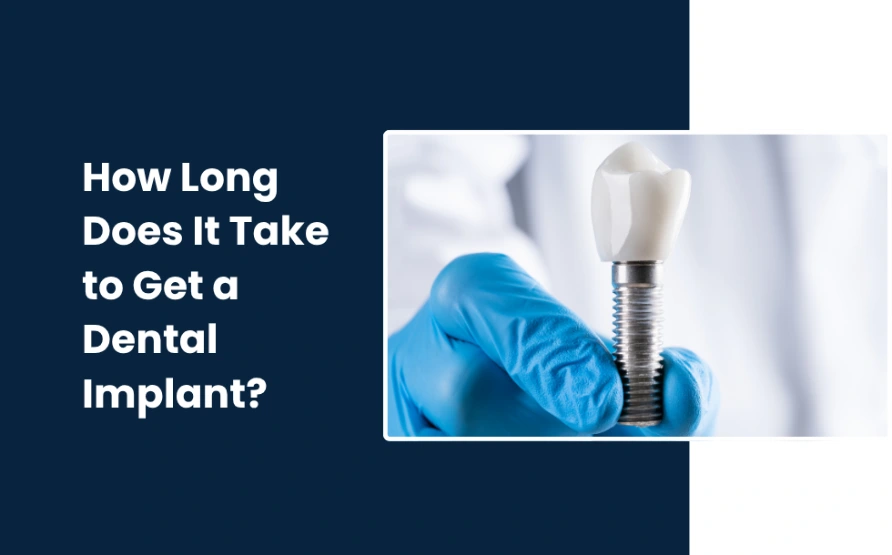When a dentist recommends an implant, one of the first questions patients ask is how long it will take. Many expect a quick fix and assume they will leave the clinic with a new tooth the same day. In reality, implants follow a careful process that lets bone and gum tissues heal around the new titanium root. The total time depends on bone quality, health history, and the type of implant system used.
This guide explains the full dental implant timeline, how long each phase takes, and what affects recovery so you can understand what to expect before starting treatment.
Dental Implant Procedure and Timeline
Implant therapy happens in planned phases so the replacement tooth can integrate naturally with the jawbone. Below is an overview from the first consultation to the final restoration.

Consultation, Treatment Planning, and Preparation
The process begins with a detailed consultation, evaluating your overall oral health. The dentist might perform an advanced 3D dental scan to assess your bone density and plan a safe treatment for you.
In some cases, if your gums and bone are healthy, the implant can even be placed right after a tooth extraction, saving you months in the overall timeline. But if there’s bone loss that usually happens when your tooth has been missing for a while, your dentist may recommend a bone graft first.
This step rebuilds a strong foundation for your artificial tooth. So, you will need about 3 to 6 months for bone graft healing time before getting the crown.
Implant Surgery
Once your mouth is ready, the next stage is placing the titanium post into your jawbone. This procedure takes 1 to 2 hours per implant and is performed under anaesthesia for your comfort. After placement, it goes through a bonding phase where it fuses naturally with your bone.
The initial healing of the gum tissue takes about two weeks, and fusion with the jawbone (osseointegration) typically takes 3 to 6 months, ensuring it has become as strong and stable as a natural tooth root. During the healing phase, you will get a temporary tooth or restoration while the artificial tooth root fuses with the bone.
The time between the dental implant and the crown is between 3 to 6 months, depending on your treatment complexity and how fast your body heals.
Abutment and Crown Placement
Once fusion is complete, the dentist attaches a small abutment that connects the implant to the final crown. The dentist takes an impression to craft a tooth that matches your natural enamel in size and colour. Crown fitting usually happens in one or two visits within a few weeks. The time between implant surgery and crown placement often ranges from three to six months, depending on healing speed and case complexity.
Aftercare
Daily brushing, gentle flossing, and professional cleanings keep the implant site healthy. Use a soft-bristled toothbrush and avoid smoking, which slows bone recovery. Regular checkups let the dentist confirm that the implant stays stable and free from irritation. With consistent care, dental implants can last ten to fifteen years or longer.
Full-Mouth and All-on-4 Dental Implant Timelines
Full-mouth and All-on-4 restorations replace several teeth at once and follow a slightly different schedule. The dentist fits temporary teeth on the same day, but full integration and placement of the permanent set takes four to six months. If extractions or grafts are needed, the process can extend beyond six months.
All-on-4 Process and Healing Time
The All-on-4 method uses four implants to support an entire arch. The dentist performs surgery and fits temporary teeth in one visit. The implant fuses completely with the bone within four to six months, after which the dentist attaches the final bridge. This approach provides immediate function while long-term stability develops underneath.
Advanced Implant Types and Timelines
Different implant systems follow unique healing patterns. Knowing their differences helps patients plan realistic expectations.
Mini Dental Implants
Mini implants are smaller in diameter and less invasive, allowing faster healing and often same-day restoration. Because they require minimal drilling, recovery usually takes weeks instead of months.
Zygomatic and Pterygoid Implants
Zygomatic and pterygoid implants anchor in dense bone near the cheek or sinus area for patients with severe bone loss. These advanced procedures need longer healing because the implants sit deeper in the bone, often taking six months or more to fully integrate.
Factors Affecting Dental Implant Timeline
Several biological and procedural factors influence how long a dental implant takes from start to finish.
Bone and Gum Health
Healthy tissue supports faster recovery. Bone grafting or sinus lifting adds months to the schedule because the graft must heal before placement.
Lifestyle and Healing Rate
Smoking, uncontrolled diabetes, certain medications, and age can slow osseointegration. Balanced nutrition, adequate rest, and steady oral hygiene help the mouth recover efficiently.
Number of Implants and Complexity
A single implant often takes four to nine months from consultation to final crown. Multiple or full-arch cases take longer because more posts are placed and additional steps, such as grafting or bridge fabrication, are required.
Recovery
Most patients return to normal routines within a few days of surgery. Mild swelling and tenderness fade quickly. Complete bone fusion continues quietly over the next few months until the new tooth feels and functions like a natural one.
Final Thoughts
Getting a dental implant is a gradual but rewarding process. Every phase, from consultation to crown placement, builds long-term strength and a natural appearance. The timeline may feel lengthy, but it allows the bone and gum tissue to adapt properly for results that can last decades.
Related Guides:
- How Long a Dental Implant Takes to Heal and Fully Recover
- Types of Dental Implants
- What Are Screwless Dental Implants?
FAQs
Is it very painful to get dental implants?
No. The dentist performs the procedure under anaesthesia, and most patients need only mild pain relief afterwards.
How long is the recovery after dental implants?
Most patients recover within two weeks after surgery. Healing inside the bone continues for three to six months as the implant fuses with the jaw.
How long after an implant do you get a crown?
The implant usually fuses with the bone within three to six months. Once healed, the dentist attaches the crown in about six weeks after the second visit.
Can dental implants be done in one day?
Some patients qualify for immediate-load implants if bone density and gum health are ideal. In those cases, the dentist can place the implant and a temporary crown in a single visit.
How long does the full-mouth implant process take?
Full-mouth or All-on-4 implants usually take four to six months to complete, though additional procedures such as grafting can extend the total time.

